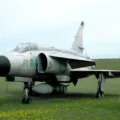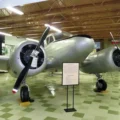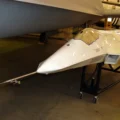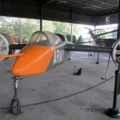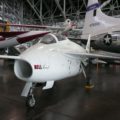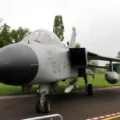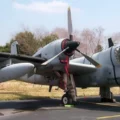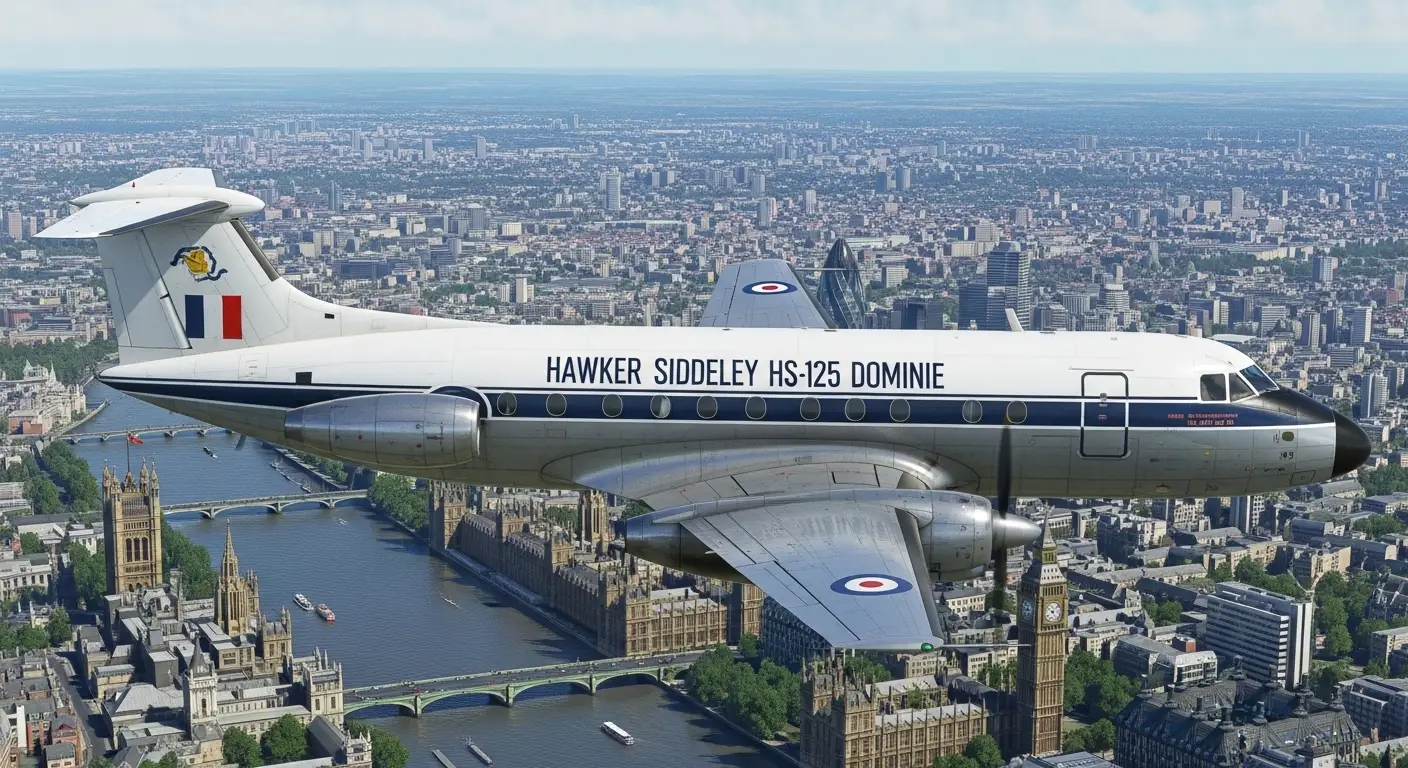
Hawker Siddeley HS-125 Dominie |
|
|---|---|
| Land | Storbritannia |
| Type | Mid-size business jet |
| Første flytur | 13 August 1962 |
| Antall bygget | 1720 |
Den British Aerospace 125 is a twinjet mid-size business jet. Originally developed by de Havilland and initially designated as the DH.125 Jet Dragon, it entered production as the Hawker Siddeley HS.125, which was the designation used until 1977. Later on, more recent variants of the type were marketed as the Hawker 800.
Kilde: Hawker Siddeley HS-125 Dominie on Wiki
| Hawker Siddeley HS-125 Dominie (BAe 125) Walk Around | |
|---|---|
| Fotograf | Meindert de Vreeze |
| Lokalisering | Unknow |
| Bilder | 29 |
Wait, Searching Hawker Siddeley for you…

Les også:
The Hawker Siddeley HS-125 Dominie: A Comprehensive Analysis of its Development, Role, and Legacy
Executive Summary
The Hawker Siddeley HS-125 Dominie T.1 represents a significant chapter in Royal Air Force (RAF) aviation history, serving as the first jet-powered navigation trainer specifically designed for such a purpose to enter service. Originating as a military derivative of the highly successful HS-125 executive jet, the Dominie provided critical training for RAF aircrew for over 45 years. Its design, rooted in a robust and adaptable civilian platform, underwent specific modifications to fulfill stringent military training requirements, enabling it to execute demanding operational profiles, including ultra-low-level flying and extensive long-range missions. The aircraft benefited from continuous avionics upgrades, ensuring its relevance throughout its extended service life. The Dominie’s eventual retirement in 2011 was not solely due to its age but was primarily driven by strategic defense reviews and a significant shift towards advanced synthetic training methodologies. Its lasting contribution is defined by its invaluable role in shaping multiple generations of RAF navigators and its compelling demonstration of how a versatile civilian aircraft design can be successfully adapted for specialized and critical military applications.1. Introduction: The Hawker Siddeley HS-125 Dominie in Context
The British Aerospace 125, initially conceived as the de Havilland DH.125 Jet Dragon, established itself as a globally successful twinjet mid-size business jet. Its remarkable journey saw it evolve through various designations, including the Hawker Siddeley HS.125, before later variants were marketed under the Hawker 800 and 1000 series. The aircraft’s commercial triumph is underscored by its impressive production run, which spanned over five decades, yielding more than 1,600 aircraft before manufacturing ceased in 2013. A testament to its widespread appeal, over 60% of its total sales were directed towards North American customers, solidifying its status as a prominent figure in the executive jet market. Within this highly successful family, the Hawker Siddeley Dominie T.1 carved out a pivotal and unique place as a dedicated military derivative. Specifically designed and operated by the Royal Air Force, it served as an advanced navigation trainer. Its historical significance is profound, as it holds the distinction of being “the first jet-powered navigation trainer designed specifically for such a purpose to enter service with the Royal Air Force”. This marked a new era in RAF aircrew training, moving away from propeller-driven or adapted combat aircraft to a purpose-built jet platform. The successful transformation of the HS-125 from a civilian business jet into a highly specialized military trainer for the RAF exemplifies a broader strategic approach in aerospace procurement. This approach demonstrates how inherently robust and versatile commercial platforms can be cost-effectively modified for critical military roles. By leveraging proven designs, established production infrastructure, and existing maintenance support networks, military forces can often achieve greater efficiency compared to developing entirely new military aircraft. The Dominie’s success in its specialized role highlights the advantages of this strategy, where the foundational reliability and widespread support of a commercial aircraft provided a strong basis for its demanding military adaptation. This pathway can lead to reduced development costs, faster procurement timelines, and streamlined logistical support, all of which are significant benefits for defense organizations.2. Development and Production Lineage of the HS-125 Series
The foundational development of the aircraft, which would eventually become the Hawker Siddeley HS-125, commenced in the late 1950s at the de Havilland Aircraft Co. The company sought a modern replacement for its respected piston-engined Dove aircraft, aiming to capitalize on the burgeoning jet age. The initial design requirements were ambitious for a business jet of its time, stipulating a cruising speed of at least 500 mph, the capacity to transport eight people along with their luggage, and the capability for non-stop flights between any two major capitals or industrial centers within Western Europe. This vision materialized in April 1961, when de Havilland, which had by then become an integral part of Hawker Siddeley Aviation following a 1960 merger, publicly announced its intention to construct this new pure jet aircraft. It was initially named the de Havilland DH125 Jet Dragon. The first prototype, registered G-ARYA with construction number 25001, was rolled out in July 1962 and successfully completed its maiden flight on August 13, 1962, a flight lasting 56 minutes. A second prototype, G-ARYB (construction number 25002), followed with its maiden flight on December 12, 1962. Both prototypes were assembled at Hatfield and were initially powered by Bristol Siddeley Viper 511 engines, each providing 2,500 lbs of static thrust. Initial dimensions included a length of 46 ft 5 ins and a wingspan of 44 ft. During development, 18 inches were added to each wing tip, increasing the overall span to 47 ft. This modification improved performance and became the standard wingspan for all 125s until the Series 800 redesign. Production subsequently transitioned to Hawarden, near Chester, where production aircraft were notably 12 inches longer than the prototypes and featured a wider 36-inch cabin door for improved access. The first production aircraft, G-ARYC (construction number 25003), was utilized for flight testing the more powerful Viper 520 engines, which produced 3,000 lbs of static thrust. Wing fences were introduced and became a standard feature from the second production aircraft, G-ASEC (construction number 25004). The aircraft underwent numerous and complex designation changes throughout its extensive service life, reflecting the dynamic corporate landscape of the British aerospace industry. It evolved from the de Havilland DH.125 Jet Dragon to the Hawker Siddeley HS.125 following the 1960 amalgamation of de Havilland into Hawker Siddeley Aviation. Subsequently, with the merger of Hawker Siddeley Aircraft and British Aircraft Corporation in 1977, it became the British Aerospace BAe 125. Later variants were marketed as the Hawker 800/1000 under Raytheon and Hawker Beechcraft ownership. Notably, the “DH.125” designation was initially retained for American exports due to its established brand recognition in that market. The HS-125 achieved significant production milestones over its extensive manufacturing period, which spanned from 1963 to 2013, resulting in the production of over 1,600 aircraft. While prototypes were assembled at Hatfield, initial production took place at Broughton near Chester. From 1996 onwards, final assembly operations were shifted to Wichita, Kansas, reflecting the aircraft’s strong North American market presence. The production line, remarkably long-lived, ceased abruptly in 2013 due to the bankruptcy of its then-owner, Hawker Beechcraft, a consequence of the Great Recession. The HS-125’s remarkable ability to not only survive but also thrive and maintain continuous production through multiple corporate acquisitions and name changes (de Havilland, Hawker Siddeley, British Aerospace, Raytheon, Hawker Beechcraft) for over 50 years is a profound testament to its fundamental design quality and enduring market demand. This sustained success, despite significant corporate restructuring, indicates that the inherent value and utility of the aircraft itself consistently outweighed the disruptions of changing ownership. The aircraft was widely recognized as “the most successful British commercial aircraft ever built, and the world’s longest in-production business jet”. Its robust engineering, reliability, and versatile capabilities meant that successive owners found it to be a valuable asset worth continuing and evolving, rather than discarding. This demonstrates that a truly strong product can transcend the instability often associated with corporate mergers and acquisitions, highlighting its inherent strength and market-driven resilience.3. Design and Core Technical Characteristics of the HS-125 Platform
The fundamental design of the HS-125 is that of a conventional low-winged monoplane, distinctively characterized by its two turbojet or turbofan engines mounted on the rear fuselage. A notable feature of its aerodynamic configuration is its slightly swept wing, which derived its planform from the larger and highly successful de Havilland Comet, a testament to its design lineage. A key design feature that significantly contributed to its operational versatility was the incorporation of large slotted flaps and airbrakes. These elements substantially enhanced its ability to operate from smaller airfields, including those with hardened grass airstrips, a capability not commonly found in business jets of its era. Specifically, the aircraft featured “double-slotted flaps” that consumed 55% of the wingspan. Upon landing, a hydraulically actuated lift-dump system could deploy these flaps to 75 degrees, providing highly effective braking that often negated the need for thrust reversers, which remained an option for decades. The HS-125 earned a reputation for exceptional ruggedness, with pilots often describing it as “built like battleships” and comparing its reliability to a “Chevy Suburban”. This inherent robustness is empirically supported by documented incidents, including its remarkable ability to survive an air-to-air missile hit in 1988, demonstrating extraordinary structural integrity. The aircraft’s powerplant evolved significantly over its production life. Early models were powered by various versions of the Bristol Siddeley Viper turbojet engine, including the Viper 511, 520, 521, 522, and 601-22 variants. Later aircraft adopted more economical turbofan powerplants, such as the Garrett TFE731 and Pratt & Whitney Canada PW300, which significantly improved fuel efficiency and extended its range. Both engines powered an electrical generator and hydraulic pump, ensuring normal operation of all aircraft systems even with a single engine failure, contributing to its reputation for reliability. In terms of systems and avionics, all control surfaces were aerodynamically balanced, with hydraulic operation for the flaps and airbrakes, while ailerons, elevators, and rudder were manually controlled. The aircraft was equipped with a comprehensive de-icing system that utilized bleed air from the engines, TKS fluid, and AC electric windshield heating. Standard avionics included integrated weather radar and a Collins-built A.P.103 autopilot. The Royal Air Force also fitted some of their aircraft with equipment designed to defend against infra-red missiles. The pressurized fuselage was designed to comfortably accommodate two pilots and typically six passengers, with various optional interior configurations offered to customers. A notable feature was the unobstructed cabin floor with 5 ft 9 in (1.75 m) of headroom and a wide 3 ft (0.91 m) cabin door. This design proved advantageous for loading bulky equipment, a characteristic particularly appealing to military operators. The original internal “up and over” cabin door was later replaced by an outward-opening door with integrated steps from the Series 400 onwards, enhancing passenger boarding and deplaning efficiency. An emergency overwing exit hatch was located over the starboard wing, with some versions featuring exits on both sides. The rear fuselage also contained a large equipment bay and, on some aircraft, additional fuel tanks. The deliberate combination of robust airframe construction, evidenced by its “built like battleships” reputation and documented survivability of missile strikes, and specific design features for short/rough field operations, such as large slotted flaps and powerful airbrakes, points to a profound engineering philosophy. This foresight in design, emphasizing operational flexibility and durability from its inception, allowed the HS-125 platform to be successfully adapted for demanding military roles. This included the Dominie’s rigorous low-level training and its secondary maritime reconnaissance duties, showcasing an airframe that was inherently prepared for a wide spectrum of operational environments beyond its initial commercial purpose. The inclusion of such ruggedness and short-field capabilities in a business jet suggests a deliberate strategy by de Havilland to broaden its market appeal, potentially including military or utility applications from the outset. This foundational versatility proved critical for the Dominie’s success, enabling it to perform challenging military training and operational roles without requiring extensive structural redesigns.Key Technical Specifications (HS.125 Series 600)
The following table provides a quantitative baseline understanding of the HS-125 platform’s capabilities, using data from the Series 600 variant. While the Dominie T.1 has specific engine and performance differences, the Series 600 data represents a well-documented and widely produced variant that effectively showcases the general performance envelope and physical characteristics of the broader HS-125 family. Presenting these specifications allows for a clear understanding of the aircraft’s fundamental attributes and provides a comparative context for understanding the Dominie’s specific role and performance.| Spesifikasjon | Value (HS.125 Series 600) |
| Mannskapet | 2 |
| Kapasitet | 8 passengers (normal), 14 passengers (high density) |
| Lengde | 50 ft 6 in (15.39 m) |
| Vingespenn | 47 ft 0 in (14.33 m) |
| Høyde | 17 ft 3 in (5.26 m) |
| Wing Area | 353.0 sq ft (32.79 m²) |
| Aspect Ratio | 6.25:1 |
| Empty Weight | 12,530 lb (5,684 kg) |
| Max Takeoff Weight | 25,000 lb (11,340 kg) |
| Fuel Capacity | 1,181 imp gal (1,418 US gal; 5,369 L) usable fuel |
| Kraftverk | 2 × Rolls-Royce Viper 601-22 turbojet engines |
| Thrust (each engine) | 3,750 lbf (16.7 kN) |
| Maximum Speed | Mach 0.78 |
| Cruise Speed | 454 kn (522 mph, 841 km/h) at 28,000 ft |
| Stall Speed | 83 kn (96 mph, 154 km/h) EAS flaps down |
| Never Exceed Speed | 475 kn (547 mph, 880 km/h) IAS |
| Rekkevidde | 1,650 nmi (1,900 mi, 3,060 km) with 1,000 lb payload |
| Service Ceiling | 41,000 ft (12,000 m) |
| Rate of Climb | 4,900 ft/min (25 m/s) |
| Take-off Run | 4,400 ft (1,341 m) |
| Take-off Balanced Field Length | 5,350 ft (1,631 m) |
| Landing Run | 3,400 ft (1,036 m) (Series 600A at typical landing weight) |
| Landing Distance from 50 ft | 2,130 ft (649 m) (at typical landing weight) |
4. The Hawker Siddeley Dominie T.1: A Dedicated RAF Navigation Trainer
In 1963, the Royal Air Force made a strategic decision to order twenty DH125s, specifically earmarking them for navigational training. While de Havilland officially designated these aircraft as Series 2, the RAF bestowed upon them the distinct and enduring name, Dominie T Mk 1. This acquisition marked a pivotal moment, providing the RAF with its first dedicated jet-powered navigation trainer. The Dominie T.1 was not merely an off-the-shelf conversion of the civilian HS-125; it incorporated several key modifications meticulously tailored for its specialized military training role. A primary distinction lay in its powerplant: unlike other early HS-125 variants, the Dominie T.1 was specifically fitted with Rolls-Royce Viper 301 turbojet engines, each producing 3,000 lbs of static thrust. This particular engine choice was optimized for its demanding training mission profiles, balancing performance with the specific requirements of a trainer aircraft. Visually, one of the most distinctive modifications was its asymmetrical window configuration. The Dominie featured six windows on the port (left) side of the fuselage but only four on the starboard (right) side. This design choice was not arbitrary; it likely optimized the internal space to accommodate specialized training equipment and multiple crew stations, prioritizing functional layout over uniform aesthetics. Furthermore, an additional ventral fin was strategically incorporated underneath the rear fuselage, contributing to the aircraft’s stability and control characteristics, which were specifically tuned for its military role. Internally, the Dominie was equipped with a sophisticated avionics package from its introduction. This included advanced navigation and communication systems such as inertial navigation systems, various radios, and radar, which were considered state-of-the-art for its time. The aircraft also featured a pressurized fuselage, enabling comfortable high-altitude flights. This capability was crucial for simulating the operational conditions that future aircrew would encounter in front-line jet aircraft, ensuring realistic training scenarios. The specific and deliberate modifications implemented for the Dominie T.1, most notably its unique asymmetrical window configuration and the integration of advanced avionics from its inception, underscore a design philosophy meticulously focused on optimizing the internal environment for complex navigation and communications training. This approach indicates that the RAF prioritized functional training space and the seamless integration of specialized equipment over standard passenger amenities. This effectively transformed the aircraft into a highly efficient and purpose-built “flying classroom,” allowing for a more effective and realistic training experience for future aircrew. The first Dominie aircraft, bearing construction number 25011 and serial XS709, conducted its maiden flight on December 30, 1964. It officially entered RAF service on March 30, 1965. This historically significant aircraft is now preserved for public viewing at the RAF Museum, Cosford, serving as a tangible link to its long and distinguished service.5. Operational History and Role within the RAF
The Hawker Siddeley Dominie T.1’s operational history within the Royal Air Force is characterized by its unwavering commitment to its primary role as an advanced navigation trainer. Entering service in 1965, the Dominie quickly superseded the Armstrong Whitworth Meteor NF(T) 14 as the RAF’s standard navigation trainer for advanced students destined for fast jets with front-line units. It was instrumental in training multiple generations of RAF navigators, later known as Weapons Systems Officers (WSOs) and Weapons Systems Operators (WSOps), who would crew aircraft like the Nimrod R1, MR2, MRA4, and the Tornado GR4. The Dominie was primarily operated by 55 (Reserve) Squadron at RAF Cranwell, which served as the central hub for its training activities. The aircraft’s training capabilities and mission profiles were remarkably diverse and demanding, often pushing the boundaries of what might be expected from a business jet derivative. From a service ceiling of 41,000 ft, the Dominie was regularly seen flying at ultra-low-level through the valleys of the famous Mach Loop in Wales, UK, as part of its low-level radar and navigation training. This high-low-high flight profile was crucial for preparing aircrew for the varied operational environments they would encounter. The Dominie also utilized its exceptional range to conduct longer-distance training flights to locations such as Malta, simulating extended operational missions. Its ability to replicate a range of conditions, from basic flight training to advanced electronic warfare scenarios, made it an invaluable asset for the RAF’s training command. Throughout its service life, the Dominie underwent continuous upgrades to ensure its suitability for training crews for modern aircraft. A significant upgrade occurred in 1996, which included the fitment of a new radar system, allowing it to remain relevant for contemporary navigation training requirements. This adaptability through modernization was key to its longevity. Beyond its primary training role, the HS-125 platform also served in other capacities within the RAF. Additional 125s, specifically the British Aerospace HS125 CC3 (a Series 700 variant) and earlier CC1 (Series 400) and CC2 (Series 600) variants, were operated by No. 32 Squadron RAF for VIP communications and light transport duties. These aircraft occasionally transported high-ranking officials, including Queen Elizabeth II and other members of the British Royal Family. During the later stages of the War in Afghanistan, 125s were also utilized for transporting military officers and other key personnel in and out of the country. During the Cold War, RAF Dominies were allocated a war role of coastal maritime reconnaissance, working with Royal Navy Offshore Patrol Vessels to escort coastal convoys around the UK, showcasing the platform’s versatility beyond its primary training function.6. Retirement and Legacy
The long and distinguished service of the Hawker Siddeley Dominie T.1 with the Royal Air Force concluded in January 2011, marking the retirement of an aircraft that had served for over 45 years. While the aircraft was indeed old, dating from the 1960s, its retirement was not solely due to reaching its fatigue life, which was anticipated to occur a few years later. Instead, the decision was primarily brought forward by the Strategic Defence and Security Review (SDSR) and a significant shift in RAF training requirements. The withdrawal of the Nimrod MR2/R1, the cancellation of the Nimrod MRA4 program, and a reduction in the size of the Tornado GR4 fleet had a direct impact on the Dominie’s role. These changes meant that the RAF ceased training new Weapons Systems Officers and Operators for these specific platforms after the current courses graduated. Consequently, the requirement for a dedicated airborne navigation training platform diminished, leading to the Dominie’s early retirement. The RAF leadership emphasized that new requirements and the transition to “synthetic training devices” and other aircraft would fulfill future training needs. The retirement of the Dominie had a notable impact on RAF training, signifying a transition towards more modern methodologies. While the aircraft had provided invaluable hands-on experience for generations of aircrew, the shift towards advanced simulators offered even more realistic training environments and updated technological teaching tools, aligning with the evolving complexities of modern aerial warfare. Despite its retirement from active service, the legacy of the Dominie T.1 endures. Several aircraft have been preserved, ensuring their historical significance is recognized. For instance, the first Dominie aircraft, serial XS709, is preserved at the RAF Museum, Cosford. These preservation efforts allow future generations to appreciate the aircraft’s design, its role in RAF history, and its contribution to aircrew training. The Hawker Siddeley Dominie remains a significant part of RAF history, representing a pioneering leap forward in jet-powered training capabilities during its introduction. Its story also powerfully demonstrates the adaptability of civilian aircraft designs for critical military training purposes. The aircraft’s long service life and its ability to be continuously upgraded for modern training needs underscore its robust design and the foresight of its original concept. Its retirement, while marking the end of an era, signifies the RAF’s ongoing adaptation to new technologies and methodologies in military training, reflecting the continuous advancements in aerospace technology.7. Conclusion
The Hawker Siddeley HS-125 Dominie T.1 stands as a remarkable example of a highly successful civilian aircraft adapted for a specialized and critical military role. Originating from the de Havilland DH.125 Jet Dragon, the HS-125 platform proved its inherent versatility and robust engineering by thriving through multiple corporate transitions and maintaining production for over five decades. Its design, characterized by a rugged airframe, efficient engine evolution, and features for diverse operational environments, provided a solid foundation for its military derivative. The Dominie T.1, specifically tailored for the Royal Air Force’s navigation training requirements, was the first dedicated jet-powered trainer of its kind. Its unique modifications, including specific Rolls-Royce Viper engines, an asymmetrical window configuration, and advanced avionics, optimized it as a “flying classroom” capable of simulating complex operational scenarios, from high-altitude flights to demanding low-level navigation. For over 45 years, the Dominie was central to shaping the skills of RAF navigators and Weapons Systems Operators, playing an indispensable role in preparing them for front-line fast jets and other critical aircraft. Ultimately, the Dominie’s retirement in 2011, while predating its full fatigue life, was a strategic decision driven by evolving defense priorities and the advent of advanced synthetic training technologies. Nevertheless, its enduring legacy is cemented by its pioneering status, its exceptional service record, and its demonstration of how a well-designed commercial platform can be effectively repurposed to meet stringent military demands. The Dominie’s history serves as a testament to the adaptability of aerospace engineering and its lasting impact on RAF aircrew development.Visninger : 47


